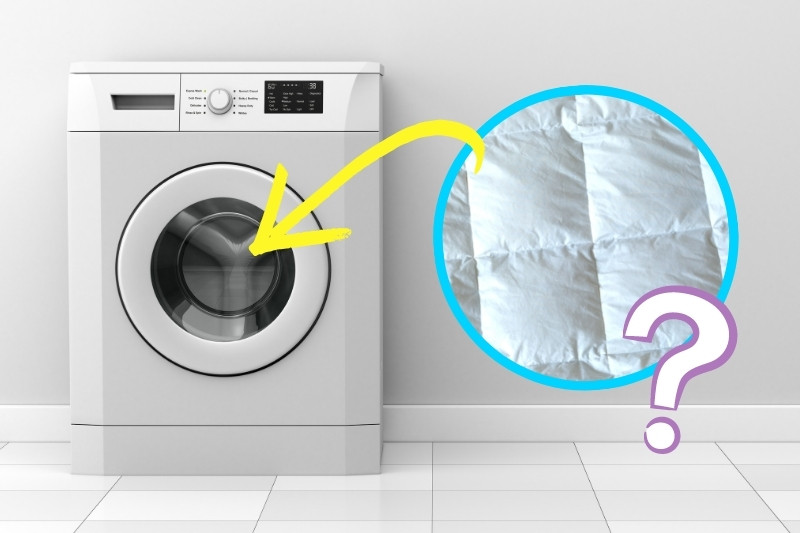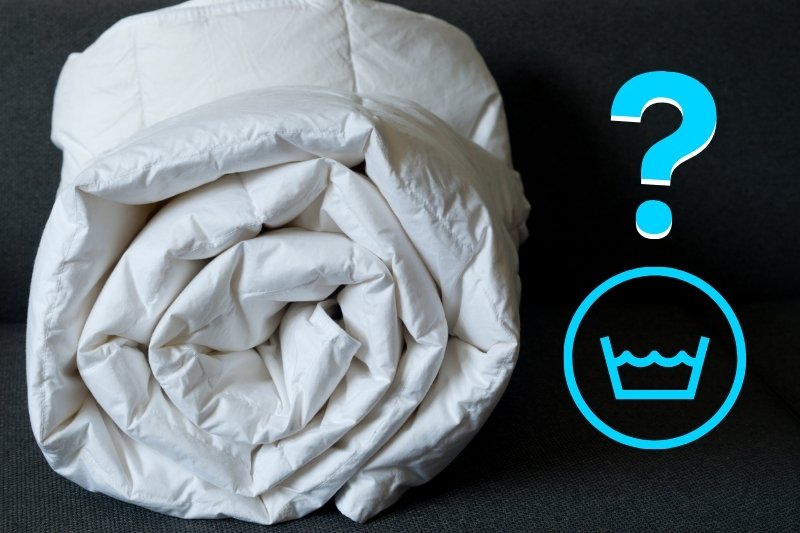If your feather duvet is in need of a clean but you’re not sure how to go about it, this is the post for you.
Below we breakdown how to wash a goose down duvet step by step, to help you give it a much-needed refresh. Read on to learn what you’ll need and how to go about it.
How Often Should I Wash my Down Duvet?
While it’s a good idea to air and fluff up a goose down duvet regularly, it shouldn’t need to be washed very often if you’re using a duvet cover. And even less if you use a flat sheet too.
If you spill something on your duvet, most stains can be spot treated with either mild detergent or a stain remover.
So, you should only need to fully wash your down duvet every 2 years. However, down pillows should be washed annually as they get dirty faster, even with a case.
Can I Wash a Goose Down Duvet in the Washing Machine?

Unless the care label advises against it, you can definitely wash your goose down duvet in your washer. In fact, this is a much safer option than dry cleaning, which involves the use of harsh chemicals that can damage the down and cause breathing issues.
However, you will need to wash your duvet a bit differently to how you’d wash regular clothes. Here’s how…
What you’ll need:
- A large, front-loading washing machine that can handle at least 7kg (size needed depends on your duvet size) – if your machine isn’t big enough, go to a laundrette.
- Mild detergent, ideally designed for down or a wool wash will do – normal detergent will strip the down of its natural oils as it is designed to break down proteins.
- Stain remover (if there are any stubborn marks)
- A tumble dryer to dry the duvet afterwards.
Method:
- Before washing your duvet, you’ll want to check three things. The first is the care label to make sure the duvet can be machine washed. Second, is whether there are any holes or tears that need sewing up to prevent feathers escaping in the machine. Thirdly, are there any stains that need pre-treating? For example, blood spots. If you find any, spot treat the stains with stain remover and cool water prior to washing.
- Next, load the duvet into your washing machine. As mentioned, you’ll want to make sure this is a roomy, front-loading machine. Small machines won’t be able to handle the weight of the wet down and agitators in top-loaders can rip the fabric as it spins.
- Once the duvet is in the machine, it’s time to add detergent. A useful tip is to use a mild detergent and scale back on how much you use. Down duvets absorb lots of water and soap suds which are hard to rinse out, so use half the recommended dose. Do not use fabric conditioner as it will coat the down and reduce its fluffiness.
- Next, select a delicate cycle with a spin speed of no more than 800rpm. Warm water is ideal for cleaning down duvets, but hot water can lead to shrinkage, so opt for a 30 or 40°c cycle at most. You’ll also want to add an extra rinse cycle before the spin to make sure all of the soap residue has been removed.
Can You Put a Goose Down Duvet in the Dryer?

Yes, you can! In fact, a tumble dryer is a key component when it comes to washing a goose down duvet. This is because your duvet needs to be completely dry before you start using it again to prevent a build-up of mildew and nasty smells.
Plus, hanging your duvet up will lead to clumping as all of the feathers will collect at one end, so it’s best to avoid line drying.
Method:
- Just like with washing, you need to make sure your dryer’s drum is big enough for the duvet. Take the duvet straight from the washer to the dryer, supporting its weight to avoid stretching the material.
Put the duvet into the machine and make sure there’s space for it to move freely, so the air can circulate properly. If the duvet is a tight fit, it will be forced against the sides of the machine which can cause the cover to melt. If in doubt, take it to a laundrette with bigger industrial machines. - Drying your goose down duvet can take a while as down absorbs a lot of water in the wash. However, it’s best to be patient and play the long game.
Excess heat can cause all sorts of issues from shrinkage to burning, so be sure to choose a low heat setting, even if it takes several cycles for the duvet to dry. - Start by setting the duvet to dry for 45 minutes on a medium temperature. When the time is up, take the duvet out and give it a shake. You can then reconfigure it and add in a couple of dryer balls to help it dry more evenly.
- Next, lower the heat setting and set the timer for 20-30 minutes. After that, you’ll want to do the same again – shake, reconfigure and repeat these short drying intervals until your goose down duvet is bone dry.
- To double check that the duvet is completely dry and avoid mould, take the duvet out of the dryer when it feels dry to the touch. Lay it out on a bed or a clean carpet and let it cool. Once cold, have a feel for any residual moisture, especially in the corners and around the seams. If it still feels damp, put it back in the machine for another 20 minutes. If dry, give it a gentle shake to fluff it up, add a cover and you’re good to go!
Looking to upgrade your laundry appliances? Check out 10 of the best washing machines and some of the most economical and efficient tumble dryers on the market, on our blog.

A proud Yorkshire lass with a love for movies, music and cosy nights in! Once a self-confessed avoider of cleaning, she’s always on the lookout for new ways to make household chores as quick and simple as possible.






